उत्तर-पश्चिमी और उत्तर-पूर्वी पहाड़ियों के अंतर्गत आलू उत्पादकता बनाए रखने के लिए जैव उर्वरक
Biofertilizers can play an important role in potato crop which has higher nutrients need because of its sparse root system. The acidic hill soils of north western and north eastern hills have P fixing problem, thus it becomes imperative to adopt environment friendly approaches through integrated use of bio-fertilizers, chemical fertilizers and organic manures in right proportion for ensuring optimum potato yield.
Nitrogen bio-fertilizers enhance the soil N availability by fixing the atmospheric nitrogen into plant usable-N by symbiotic or non-symbiotic fixation, whereas, P solubilizing bacteria (PSB) or fungi from phosphate bio-fertilizers produce organic acids which in release soluble P from native or insoluble P form of organic P and phosphate minerals.
Bio-fertilizers refer to living organisms capable of augmenting plant nutrient supplies through use of renewable resources. They can be broadly classified as nitrogen or phosphorus bio-fertilizers.
In potato, mainly non symbiotic N fixer, PSB and plant growth promoting bacteria have been found beneficial in rainfed, particularly in hills. In these ecosystems, potato is cultivated during summer season and soils contain high organic matter. These soils are acidic in nature and therefore, more P fixation take place into insoluble compound of Al and Fe ions.
The use of chemical fertilizers had played a vital role in bringing green revolution in the country in late sixties. However, in the recent years their indiscriminate uses have adversely affected soil productivity and its fertility resulting in decline in crop productivity. Moreover, the continuous mining of nutrients from soil reserves has led to depletion of essential nutrients.
In addition, the increased dependence on fertilizer imports at a high international price necessitates the need to explore and exploit the potential alternative sources of plant nutrients. Of late bio-fertilizers have shown a good promise and have emerged as an important component of integrated plant nutrients supply (IPNS).
Bio-fertilizers are cheaper, pollution free and based on renewable energy source and improve soil physical properties, tilth and soil health in the long run. In this popular paper, results of field experiments conducted at Shimla in north western hills and at Shillong in the north eastern hills have been reviewed.
Use of biofertilizers in potato in north western hills
North western hills cover the Himalayan hills of Himachal Pradesh, Jammu and Kashmir and Uttar Pradesh. Summer crop of potato is grown from March/April to September under rainfed conditions in high hills (>2742m msl).
In Lahaul Spiti and Kinnaur valleys, summer crop is taken from May to September under irrigated conditions. In most of the higher hills high rainfall, low sunshine and late blight are the major determinants.
In mid hills (915-1523m msl) two crops of potato are grown in spring (Jan to June) as irrigated and in autumn (August/September to November) as rainfed crop. In lower hills (<914m msl) crop is grown from Oct/Nov to May.
Beneficial effects of non-symbiotic nitrogen fixers have been reported from north western hills. At Shimla, Azotobacter inoculation has been found beneficial and increased the yield of potato under rainfed condition in absence of N. However, as the N doses increased the effect of this non symbiotic N fixer decreased and it became non significant at 180 kg N/ha.
Azotobacter inoculation improved leaf N, N use efficiency as well tuber yield, particularly at lower N doses. Tuber inoculation with Azotobacter aloneincreased the leaf N, probably due to increased N availability from soil to the plant at early stage of crop growth when plant needs are high.
At harvest, it was found that inoculation with Azotobacter alone or with N significantly increased number of medium and large sized tubers. Likewise, Azotobacter alone increased the tuber yields by 22 q/ha over control and enhanced N use efficiency significantly in presence of lower doses of N i.e. at 25% and 50% of recommended N dose.
Thus, combined application of N along with tuber inoculation with Azotobacter proved to be more productive in terms of total tuber numbers yield and recovery (Fig.1).
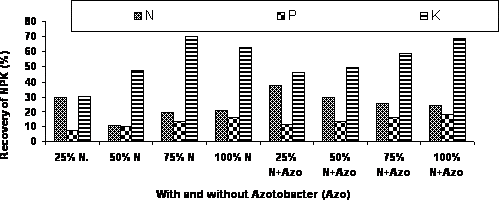
Fig. 1. Effect of N and Azotobacter on recovery of NPK
In another study at Shimla during summer season of 2007, application of P and phosphorus solubilizing bacteria (PSB) alone or in combination significantly increased tuber yield with the highest increase was obtained with PSB (Table 1).
Maximum tuber numbers were obtained with 100 kg P2O5/ha, (the recommended dose of P for the region) and was statistically at par with PSB+25 or 50 kg P2O5/ha.
Grade wise tuber yield showed that P application along with seed inoculation with PSB significantly increased the yield of medium sized tubers, whereas, it had marginal effect on yield of large sized tubers. Seed inoculation with PSB in conjunction with lower doses of P viz., 25 and 50 kg P2O5/ha not only gave higher yields but also led to better nutrient utilization of P from fertilizers and soils.
This was further reflected in higher nutrient recovery of P by potatoes with highest P recovery obtained with application of 25% recommended P dose along with seed inoculation with PSB (Fig. 2).
Table 1. Effect of phosphorus and PSB on potato nutrition
|
P (%RDP) |
Dry matter (%) |
Tuber (000/ha) |
Tuber yield (q/ha) |
Nutrient uptake (kg/ha) |
|||||
|
Small (<25 g) |
Medium (25-75 g) |
Large (>75 g) |
Total |
N |
P |
K |
|||
|
Control |
15.46 |
445 |
42 |
100 |
140 |
282 |
43.24 |
4.39 |
56.31 |
|
12.5 |
16.80 |
407 |
32 |
110 |
168 |
300 |
83.62 |
6.23 |
79.89 |
|
25.0 |
16.11 |
467 |
25 |
104 |
191 |
320 |
95.01 |
8.07 |
92.91 |
|
100.0 |
16.02 |
548 |
35 |
124 |
185 |
344 |
107.40 |
9.91 |
113.97 |
|
25+PSB* |
16.18 |
522 |
38 |
114 |
165 |
317 |
104.60 |
9.70 |
99.28 |
|
50 +PSB* |
16.20 |
523 |
36 |
144 |
159 |
339 |
108.29 |
10.50 |
105.33 |
|
PSB* |
17.04 |
450 |
33 |
115 |
145 |
293 |
95.00 |
7.95 |
96.65 |
|
(P ≤0.05) |
0.33 |
32 |
NS |
11 |
25 |
23 |
14.76 |
2.29 |
15.73 |
RDP = recommended dose of P, *PSB applied through seed inoculation
In another field study at Shimla during summer season of 2007, seed inoculation with PSB in conjunction with 50, 75 and 100% recommended dose of P application not only resulted in higher yields but also better nutrient utilization as was evident by its positive effect on nutrients uptake and reflected in higher nutrient recovery of NPK by potatoes.
This may be due to beneficial effect of PSB in the acidic soils by the release of native P present in the soil which in turn makes sufficient P in soil solution around root zone as indicated by the higher NPK recoveries.
The beneficial effect of phosphate solubilizing microorganisms attributed the release of P from inorganic fractions of Al-P, Fe-P and Ca-P and reducing P fixing capacity of the acidic soil.
The plant growth promoting bacteria had great promise by better growth of crop, yield and nutrient economy. Two cultures of plant growth promoting bacteria viz. Bacillus subtilus and Bacillus cerus were evaluated in potato crop.
Bacillus cerus was superior to Bacillus subtilus at all levels of fertilizers. On yield basis, use of plant growth promoting bacteria Bacillus cerus economized on NPK fertilizer dose by 25%. Bacillus subtilis and Bacillus cereus separately increased the tuber yield of potato.
In acidic soils of Kufri, in high hills of Shimla in north western Himalayas, a positive response to bio-fertilizers on potato growth parameters was observed by significant increase in plant height, number of leaves and stems/plant.
Application of 50% NPK along with tuber inoculation with bio-fertilizers produced 222 q/ha of tubers as compared to 101 q and 241 q/ha, produced under control and with 100% NPK dose, respectively. The nutrients uptake as well as fertilizer use efficiency was also higher in presence of bio-fertilizers.
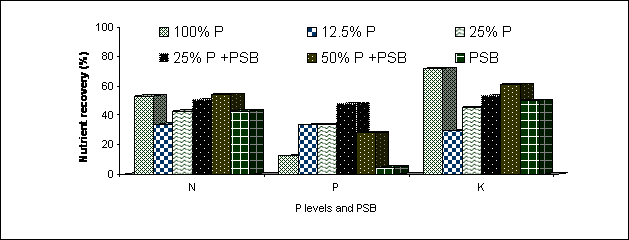
Fig. 2. Effect of P levels and PSB on nutrients recoveries by potato
Use of bio-fertilizers in potato in north eastern hills
North eastern hills comprises of Meghalaya, Manipur, Tripura, Nagaland, Arunachal Pradesh and Mizoram. Rainfall in these hills is high (3135-4450 mm) with associated problems of acidic soils, high fixation of phosphorus, leaching of nutrients and soil erosion.
Inoculation with phospho bacteria (Pseudomonas striata) significantly increased the tuber yield at Shillong (Meghalaya) during summer season of 1999 and 2000. However, its effect on plant stand was not significant compared with no inoculation. Response to phosphorus increased when either seed tubers were inoculated with Pseudomonas striata or crop was fertilized with nitrogen (Fig. 3).
At Shillong, application of phosphate solubilizing bacteria in combination with different phosphatic fertilizers using two potato cultivars Kufri Megha and Kufri Jyoti increased crop yield and tuber size. The net returns increased with increasing rates of P and were higher with phosphate solubilizing bacteria inoculation (Fig. 3).
In field experiments at Shillong, during the summer season of 1996-98, the biofertilizers (Azotobacter and/or phospho-inoculant culture of Pseudomonas striata) were evaluated in combination with N at 0, 50, 100 and 150 kg/ha on the yield of potato cv. Kufri Jyoti. The tuber yield, tuber number and tuber size increased with increasing rates of N.
Inoculation with Azotobacter and P. striata resulted in the highest tuber production and tuber number regardless of N rates, although differences in tuber production due to inoculation of different biofertilizers at 100 and 150 kg N/ha were not significant. Net returns increased with increasing N rates and were highest with Azotobacter and P. striata inoculation (Fig.4).
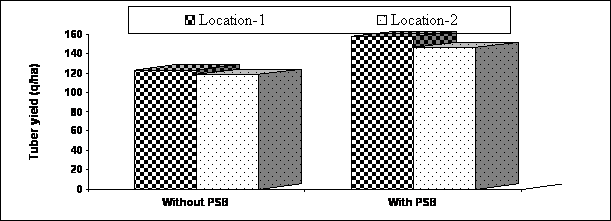
Fig3. Effect of phosphobacteria on tuber yield of potato (q/ha)
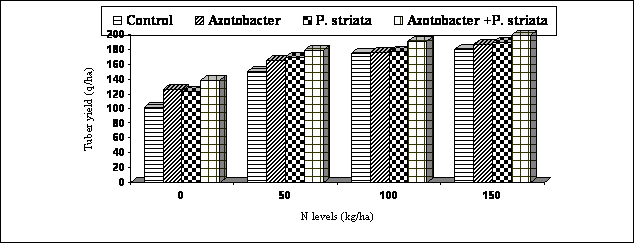
Fig. 4. Effect of biofertilizers at different levels of N on tuber yield of potato (q/ha)
In acidic soils of Shillong, results from three years study showed that inoculation of seed tubers with bio-fertilizers (Azotobacter+phosphobacteria) was superior to application of Azotobacter or phosphobacteria alone through soil application as compared to control.
Potato yield significantly increased with the application of Azotobacter (soil application), phosphobacteria (soil application), Azotobacter (tuber inoculation), phosphobacteria (tuber inoculation), Azotobacter+phosphobacteria (soil application) and Azotobacter+ Phosphobacteria (tuber inoculation) as compared to no bio-fertilizer application.
Combined use of Azotobacter+ phosphobacteria gave higher tuber yield and net return compared to their separate use of bio-fertilizer and control (Table 8 and 9).
PSB plays an important role in solubilizing fixed P in soil particularly in acid soils. In acidic soils of Shilong in north eastern hill region, application of Microphos inoculants culture + FYM at 20 t/ha had a significant effect on potato yields.
The increase due to Microphos alone was 15.5%, indicating that in soils with sufficient organic matter, the bio- fertilizers application are able to reduce the P fixation thus releasing P from the native soil P.
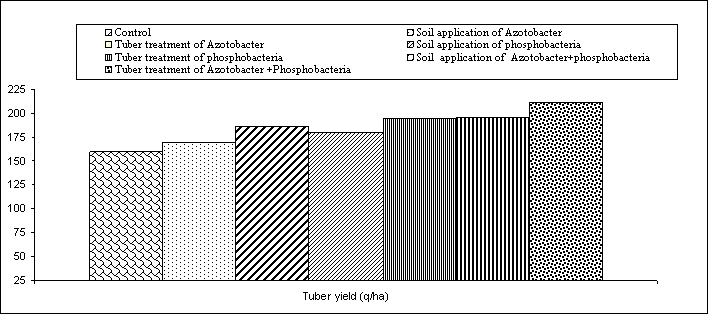
Fig. 5. Effect of biofertilizers on emergence, tuber number and yield of potato
Conclusion:
Studies conducted on role of Azotobacter, phosphorus solubilizing bacteria and plant growth promoting bacteria on N and P economy under rain fed conditions in north western and north eastern hills of Shimla and Shillong, revealed that combined application of N along with Azotobacter improved number of medium and large sized tubers, total tuber yield and also nutrients uptake by potato.
Azotobacter enhanced the leaf N content in early stages of crop growth. The combined application of phosphorus and phosphorus solubilizing bacteria improve P use efficiency. P application as well as PSB applied through seed tuber inoculation gave higher yields of medium sized tubers and total tuber yield and recovery of P.
The seed inoculation with Azotobacter and phosphate solubilizing bacteria reduced N and P requirement, improved the yield of tubers and net return in north western and north eastern hills of India.
Authors
MK Jatav*, VK Dua**, Manoj Kumar**, Sushil Kumar**, RP Sharma*** and Ramesh Chand Bairwa****
* Central Institute for Arid Horiculture, Beechwal, Bikaner-334006
**Crop Production, Central Potato Research Institute, Shimla-171 001
***NBSS-LUP, Regional Centre, Udaipur-313001
****SKRAU, Bikaner-334006
